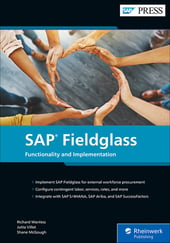In the last few years, the concept of total workforce management made it to the boardroom.
What started out as a buzzword, has become a joint strategy for human resources, procurement and IT systems landscape. So much so, that total workforce management is the “gold standard” when it comes to managing companies’ internal and external workforce categories holistically.
The composition of the workforce has changed in recent years, with almost half of the workforce being external workers. Businesses must be able to better manage and analyze their permanent employees and external staff. The productized integration between SAP Fieldglass and SAP SuccessFactors provides a sturdy solution to connect the systems and workflows while ensuring transparency, visibility, and market insights.
Internal workers are categorized as full-time or part-time employees which are on the company’s payroll. External workers are far more diverse. They can be the classic temporary contingent worker, freelancer or consultants, gig economy workers, or outsourced services. The classification of external workers in the respective categories is fluid. Often, it helps to not only look at the contract types but also the procurement and administration process to categorize workers into the appropriate segment. Total workforce management includes all these types of human talent in its broadest sense, no matter whether they are permanent hires or any type of contingent worker.
This blog post will focus on the integration capabilities of SAP Fieldglass, particularly with SAP SuccessFactors as part of a total workforce management strategy.
SAP Fieldglass: Integration Overview
With a combination of easy-to-use configurable integration connectors and tightly coordinated productized integrations, SAP Fieldglass offers a unique range of options to tie the application into a company’s wider IT landscape. Integrations are used for continuous, planned data exchange between SAP Fieldglass and other software systems. There are two types of integrations: standard integrations and productized integrations to SAP products in the intelligent enterprise (such as SAP SuccessFactors).
Standard integrations are typically used to synchronize data; for example, master data, rates, or other base modules. They are based on standard connectors that are available as an upload or download variant for uploading or downloading data to SAP Fieldglass. The connectors are often used on a manual, ad hoc basis by administrators to add, modify, or delete information in SAP Fieldglass. Standard integrations are constantly evolving and adapting new data formats and development standards. They are also used for transactional integrations with systems that aren’t supported by productized integrations. They can be used to simplify expense and human resource management integrations with non-SAP ERP and HR systems.
Productized integrations are specially prepared integration packages for other SAP products without development requirements and support spend management, procurement, and workforce management. They are often transactional integrations that accompany the end-to-end process as part of total spend management and total workforce management.
Both types of integrations can be managed independently by the client or SAP Partner using a dedicated user role called the Configuration Manager. This feature is the foundation of solid, self-managed integrations.
Beyond the integrations with the larger core IT applications, SAP Fieldglass is embracing the use of ever more targeted integrations to facilitate the completion of specific tasks. Looking outwards from SAP Fieldglass, this includes integrations to and from focused best-of-breed applications and platforms. This allows clients to easily augment the capabilities of SAP Fieldglass with other useful tools. A great example of this is the talent channel integration suite that can be used to get job posting details from SAP Fieldglass out to key job boards and freelancer systems as soon as the job posting is approved in SAP Fieldglass. These talent channel systems can in turn allow candidates to submit their applications straight through to SAP Fieldglass, allowing for far shorter hiring times.
HR Workflow Integration with SAP SuccessFactors
In many companies, the composition of the workforce has changed in recent years, with almost half of the workforce being external workers. Businesses must therefore be able to better manage and analyze their permanent employees and external staff. The productized integration between SAP Fieldglass and SAP SuccessFactors provides a sturdy solution to connect the systems and workflows.
SAP Fieldglass instances can be fully integrated with an HR system for position and worker data, while also being integrated end to end with a procurement system for purchase orders and invoicing. In an SAP landscape, this could include SAP SuccessFactors integrations for position management/job postings, as well as worker data and SAP Ariba integrations for work orders and invoices. Additional integration points can also be added, for example, updating user role data from an identity and access management system or importing contingent worker time entry data from the client’s badging or time capture systems.
The visibility and control of the external workforce in SAP Fieldglass, combined with the management of permanent employees in SAP SuccessFactors, is the key to total workforce management. Total workforce management means that the workforce in its entirety can be managed holistically and overseen, regardless of whether it’s an internal employee or external worker. SAP SuccessFactors is SAP’s cloud-based human capital management (HCM) solution that is mainly used to manage internal, permanent staff. In addition to recruiting candidates, core topics include talent and performance management and business analytics. SAP Fieldglass is the cloud-based solution for managing contingent labor, services contracts, and profile workers. It’s less about worker development than accurate financial accounting of time sheets, expense sheets, and statement of work related line items.
Both systems have in common the ability to provide an overview of their respective worker categories. Productized integrations provided by SAP combine these two cloud applications for a holistic view of the composition of a company’s workforce. The seamless integration of data provides visibility of the positions of permanent employees alongside external workers in temporary contingent or services contracts for an improved user experience (UX). Open positions and the entire workforce are visible and accessible in their entire lifecycle.
Productized Integrations
Productized integrations are prebuilt integration packages that solve a specific problem; for example, the integration between SAP Fieldglass and SAP SuccessFactors. You can imagine such a package as a ready-made baking mixture. Instead of looking for a recipe yourself and having to buy and measure all ingredients, you use a product that already puts all the ingredients together in a box of measured portions. All you need to do is open the box and get started. Productized integrations are similar. They already contain all connectors that are tailored to facilitate the data flow between both systems. The integration between SAP Fieldglass and SAP SuccessFactors focuses on three main areas:
- Integration of master data in the company structure.
- Integration of job postings based on a vacant position; also known as position management.
- Worker data integration.
Job posting and worker data integrations are called transactional integrations; that is, integrations that support the procure-to-pay process. Transactional integrations focus on the main touchpoints in the workflows between the two systems. A number of integrations of the company structure are available to ensure the synchronization of master data between the systems. This master data includes cost center, business unit, site, and legal entity. With the standard integration connectors of both systems, the company structure data is extracted from SAP SuccessFactors and uploaded to SAP Fieldglass.
The integration uses single sign-on (SSO) and data transfer to bring users from the vacant position in SAP SuccessFactors directly to the creation of a job posting in SAP Fieldglass. In SAP Fieldglass, the job posting is already prepopulated with the relevant information from the position. From there, you can continue to find and hire external workers. After a job seeker has been hired and created as a contingent worker in SAP Fieldglass, the details of that worker can be transferred back to SAP SuccessFactors in a contingent worker profile. As a result, all employees are fully visible, which is total workforce management. Productized integrations between SAP Fieldglass and SAP SuccessFactors leverage the standard integration capabilities of both systems and the most appropriate data transfer options for each integration point. You don’t need to make any further settings for this; they are preset in the productized integration package. Let’s take a look at each of the three main integrations between SAP Fieldglass and SAP SuccessFactors.
Master Data Integrations
The master data integrations are one-sided workflows that replicate the company structure from SAP SuccessFactors to SAP Fieldglass. In SAP SuccessFactors, you use a set of predefined templates that are available on SAP API Business Hub under Integration Center Definition (file format ICD) and can be uploaded to the Integration Center in the company’s SAP SuccessFactors Employee Central instance. These files define which data to extract from SAP SuccessFactors and how it needs to be formatted to be aligned with SAP Fieldglass. In SAP Fieldglass, the standard connectors for uploading master data to the company structure are used to receive these extracts from SAP SuccessFactors Employee Central, create the master data objects in the system accordingly, and maintain them. These integrations are batch connections. The transfer of data between the systems takes place via Secure File Transfer Protocol (SFTP), with the schedules being coordinated for regular exchange.
Position Management Integration
The SAP SuccessFactors Position Management integration with an SAP Fieldglass job posting is a real-time integration. This transfers the SAP SuccessFactors Employee Central position data to the SAP Fieldglass job posting via OData. At the same time, SSO based on Security Assertion Markup Language (SAML) is used to log the user on to the corresponding screen in SAP Fieldglass directly from the position management screen in SAP SuccessFactors Employee Central. The job posting details are sent back to SAP SuccessFactors after the posting is submitted from SAP Fieldglass.
Worker Data Integration
Worker data integration uses a standard connector in SAP Fieldglass, along with the Standard Worker Upload OData application programming interface (API) in SAP SuccessFactors. Because these two formats are very different and require multiple calls to SAP SuccessFactors, you need to use SAP Integration Suite to manage both the transfer and transformation of the data. A predefined integration flow (iFlow) is provided for this purpose.
Conclusion
The productized integration between SAP Fieldglass and SAP SuccessFactors is based on aligned master data and covers position management and worker data. It’s a fairly simple setup that leverages the appropriate integration options from SAP Fieldglass and SAP SuccessFactors at each stage, including event-driven data transfer and SSO. Through the integration, you create a unified UX for the end-to-end business process in total workforce management. The benefits to your business are clear: you have a holistic view of your workforce and can use analytics tools to combine your permanent and contingent workforce to ensure full visibility into headcount and full cost control.
This post was originally published 4/2022.




Comments